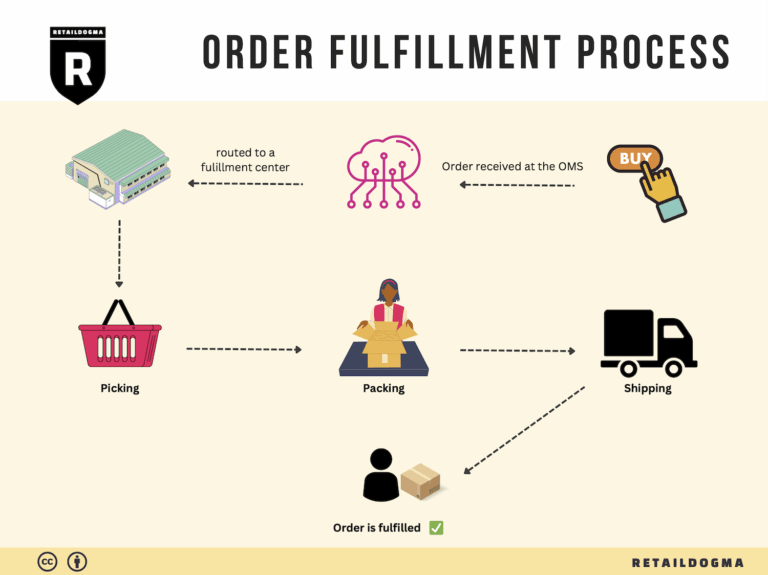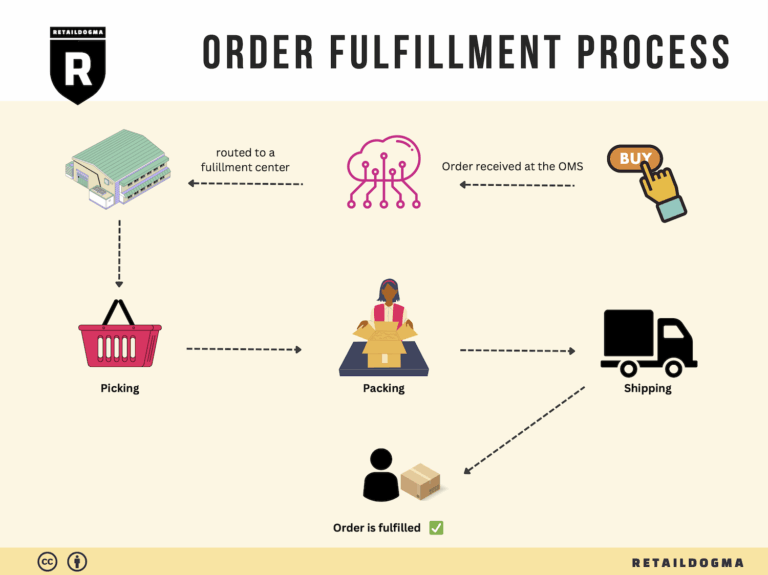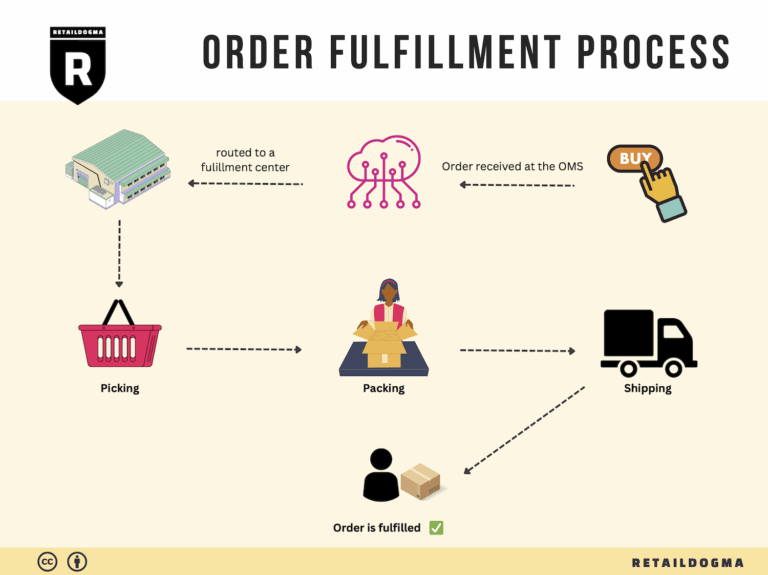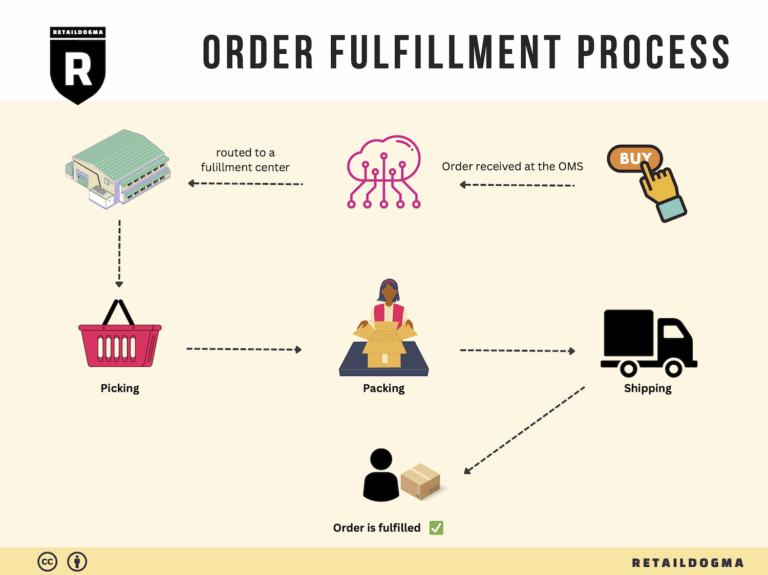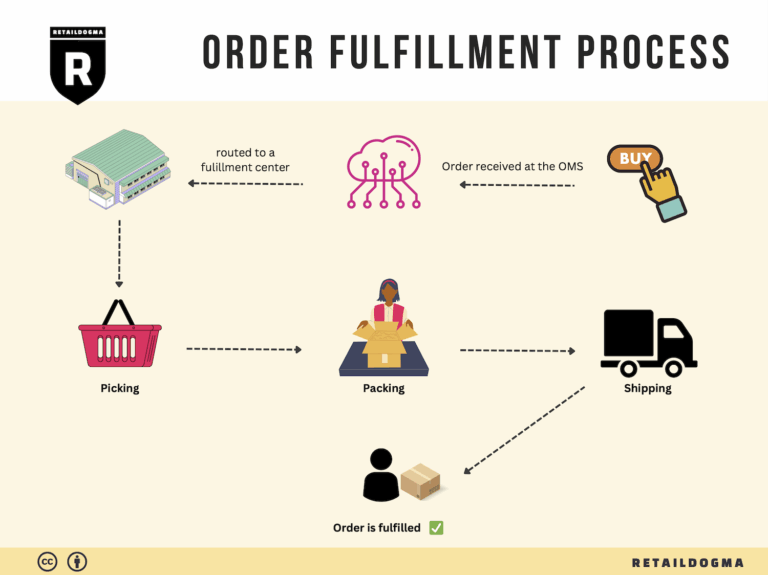How Order Fulfillment Works: A Step-by-Step Guide for Businesses
What is E-commerce Fulfillment? An Introduction for Growing Businesses
As an e-commerce business grows, many owners find themselves grappling with the logistics of order fulfillment. The excitement of increased sales can quickly turn into overwhelm when faced with the complexities of packing and shipping orders. Managing inventory, processing orders, and ensuring timely delivery can become a daunting task, detracting from the core focus of growing your business. This is where understanding e-commerce fulfillment becomes essential.
E-commerce fulfillment is simply the process of getting a product from your warehouse or supplier to the customer’s doorstep. It encompasses everything from receiving inventory to packing orders, shipping, and handling returns. As a growing business, choosing the right fulfillment model can make all the difference in maintaining efficiency, reducing costs, and enhancing customer satisfaction.
In this guide, we will explore various fulfillment models, such as Third-Party Logistics (3PL) and Fulfillment by Amazon (FBA), to help you identify the best fit for your business needs. We will delve into the core services offered by fulfillment partners, including inventory management, order processing, and shipping logistics. Understanding these services will empower you to evaluate potential partners based on what they can offer to streamline your operations.
Choosing the right fulfillment partner is a critical decision that can impact your bottom line and customer experience. We will provide practical tips on what to look for when selecting a fulfillment company, including technology integration, scalability, and customer service capabilities. Additionally, we will discuss pricing structures, helping you understand the costs associated with various fulfillment options so you can make informed budgeting decisions.
Ultimately, the goal of this guide is to empower e-commerce businesses to make smart, strategic decisions about their logistics. By understanding the ins and outs of e-commerce fulfillment, you can ensure that your operations support growth, enhance customer satisfaction, and allow you to focus on what you do best—building your brand and serving your customers.
What You’ll Learn In This Guide
- What is E-commerce Fulfillment? An Introduction for Growing Businesses
- The Order Fulfillment Process: From ‘Buy’ Button to Customer’s Door
- Comparing Fulfillment Models: In-House vs. 3PL vs. Dropshipping
- A Deep Dive into Amazon FBA: Pros, Cons, and Who It’s For
- Core Services Offered by Fulfillment Centers
- How to Choose a Fulfillment Partner: A 6-Point Checklist
- Understanding Fulfillment Pricing: A Breakdown of Common Fees
- Frequently Asked Questions (FAQs) about Fulfillment
- Conclusion: Is Outsourcing Fulfillment the Right Move for Your Business?
- Important Disclaimer
The Order Fulfillment Process: From ‘Buy’ Button to Customer’s Door
1. Receiving Inventory
The order fulfillment process begins with receiving inventory at the fulfillment center. When products arrive, they are unloaded and checked against shipping documents to ensure that the correct quantities and items have been delivered. This step is crucial as it establishes the foundation of the inventory management system. Each product is assigned a unique Stock Keeping Unit (SKU), which helps track the item throughout the fulfillment process.
Proper receiving practices prevent discrepancies in inventory records, which can lead to stockouts or overstock situations. An efficient receiving process not only saves time but also reduces errors that can impact customer satisfaction. By accurately logging SKUs and quantities, businesses can maintain real-time inventory visibility, allowing for better planning and forecasting.
2. Warehouse Storage
Once the inventory is received and verified, it is stored in designated areas within the fulfillment center. Efficient warehouse storage is essential for optimizing space and ensuring quick access to products. Items are typically organized based on their SKU, size, and demand frequency. This systematic approach is often referred to as warehouse zoning or slotting.
Effective storage solutions reduce the time required to locate products when orders are placed. Implementing an organized system helps streamline the picking process, ultimately leading to faster order fulfillment. Additionally, proper storage minimizes damage to goods, which can occur when items are improperly stacked or stored in unsuitable conditions.
3. Order Picking
Order picking is the process of retrieving items from storage to fulfill customer orders. When an order is placed, the fulfillment center generates a pick list, detailing which items and quantities need to be collected. This step is critical as it directly impacts order accuracy and speed.
There are various picking methods, including single order picking, batch picking, and wave picking, each suited for different business needs. For instance, batch picking allows workers to gather items for multiple orders simultaneously, increasing efficiency during peak periods. Accurate picking not only ensures that customers receive the right products but also enhances overall operational efficiency, reducing the likelihood of returns and customer dissatisfaction.

4. Order Packing
Once the items are picked, they are taken to the packing station, where they are prepared for shipping. Packing involves placing the products in appropriate packaging materials to protect them during transit. This step is vital for ensuring that items arrive at the customer’s door in perfect condition.
Key considerations during packing include using the right-sized boxes, protective materials like bubble wrap, and including packing slips or invoices. Additionally, businesses often implement branding elements in their packaging, such as custom boxes or thank-you notes, to enhance the customer experience. Efficient packing processes contribute to reducing shipping costs by minimizing dimensional weight and ensuring that packaging materials are used effectively.
5. Shipping & Delivery
The final step in the order fulfillment process is shipping and delivery. Once orders are packed, they are labeled and handed over to carriers for transportation. This stage involves selecting the most cost-effective shipping method, which can vary based on factors such as delivery speed, destination, and weight.
Timely shipping is critical for customer satisfaction and can significantly influence repeat purchases. Many fulfillment centers offer integration with various shipping carriers, enabling businesses to automate label printing and track shipments in real time. Effective shipping not only ensures that products reach customers quickly but also provides transparency throughout the delivery process, allowing customers to monitor their order status.
In conclusion, understanding and optimizing each step of the order fulfillment process—from receiving inventory to shipping and delivery—can enhance operational efficiency and improve customer satisfaction. For e-commerce businesses, leveraging third-party logistics (3PL) can further streamline these processes, allowing owners to focus on growth and customer engagement.

Comparing Fulfillment Models: In-House vs. 3PL vs. Dropshipping
Fulfillment Model Comparison
| Model | Who Handles Inventory | Best For (Business Stage) | Key Advantage | Key Disadvantage |
|---|---|---|---|---|
| In-House Fulfillment | Business (internal team) | Established businesses | Full control over inventory and processes | High overhead costs and resource-intensive |
| Third-Party Logistics (3PL) | 3PL provider | Growing businesses | Scalability and expertise in logistics | Less control over the fulfillment process |
| Dropshipping | Supplier or manufacturer | Startups and small businesses | Low upfront investment and minimal risk | Lower profit margins and reliance on supplier reliability |
In-House Fulfillment
In-house fulfillment involves managing all aspects of the supply chain within the business itself. This includes inventory management, order processing, packing, and shipping. Typically, established businesses with a stable customer base and sufficient resources adopt this model. The main advantage of in-house fulfillment is that it grants businesses complete control over their inventory and fulfillment processes. This control can lead to improved quality assurance, faster response times, and the ability to create a tailored customer experience. However, the downsides include higher overhead costs associated with staffing, warehousing, and logistics technology. Additionally, it requires significant investment in infrastructure and can be resource-intensive, potentially diverting focus from core business activities such as product development and marketing.
Third-Party Logistics (3PL)
Third-party logistics (3PL) providers offer businesses a comprehensive solution for managing their logistics and supply chain needs. This model is particularly beneficial for growing businesses that are scaling operations but may not yet have the resources or expertise to manage logistics in-house. 3PLs handle various aspects of fulfillment, including warehousing, inventory management, order processing, shipping, and returns management. By outsourcing these functions, businesses can leverage the expertise and efficiencies of 3PL providers, allowing them to focus on strategic initiatives and customer engagement. Additionally, many 3PLs offer scalable solutions, enabling businesses to adjust their logistics needs as they grow. However, the trade-off is that businesses relinquish some control over the fulfillment process, which can lead to potential communication issues and concerns about service quality.
Dropshipping
Dropshipping is a fulfillment model where the retailer does not keep products in stock. Instead, when a customer makes a purchase, the retailer purchases the item from a third-party supplier who then ships it directly to the customer. This model is particularly attractive for startups and small businesses due to its low upfront investment and minimal risk. Retailers do not need to invest in inventory or warehouse space, making it easier to start and operate an e-commerce business. However, dropshipping comes with significant drawbacks. Retailers often face lower profit margins as they pay wholesale prices without the ability to mark up significantly. Additionally, reliance on suppliers for inventory and shipping can lead to inconsistencies in product availability and delivery times, potentially harming customer satisfaction. Retailers must also navigate the challenge of managing returns and customer service without direct control over the fulfillment process.
Conclusion
Choosing the right fulfillment model is crucial for e-commerce businesses aiming to scale effectively. In-house fulfillment offers control but comes with high operational costs, while 3PLs provide scalability and expertise at the expense of some control over logistics. Dropshipping is an accessible entry point for startups, but it can lead to challenges in profit margins and supplier reliability. Understanding the strengths and weaknesses of each model will empower business owners to make informed decisions that align with their growth strategies and operational capabilities.
A Deep Dive into Amazon FBA: Pros, Cons, and Who It’s For
Understanding Fulfillment by Amazon (FBA)
Fulfillment by Amazon (FBA) is a service offered by Amazon that allows sellers to store their products in Amazon’s fulfillment centers. With FBA, Amazon takes care of storage, packaging, and shipping of products directly to customers. This service is particularly appealing for e-commerce businesses looking to leverage Amazon’s extensive logistics network and customer base.
How FBA Works
-
Inventory Storage: Sellers send their products to Amazon’s fulfillment centers. Once received, Amazon takes over the responsibility of managing that inventory.
-
Order Processing: When a customer places an order for a product listed by a seller, Amazon retrieves the item from its warehouse, packs it, and ships it to the customer.
-
Customer Service: Amazon also handles customer service and returns for those orders, providing a seamless experience for both sellers and buyers.
-
Multi-Channel Fulfillment: Sellers can use FBA to fulfill orders not only from Amazon but also from their own websites and other sales channels. This flexibility allows for broader sales opportunities.
-
Prime Eligibility: Products fulfilled through FBA are eligible for Amazon Prime, which can significantly increase visibility and sales due to the appeal of fast, free shipping.
Pros of Using FBA
1. Prime Eligibility
One of the most significant advantages of FBA is that products are eligible for Amazon Prime, which attracts millions of loyal customers who prioritize fast shipping. This can dramatically boost a seller’s sales, as Prime members are more likely to purchase items that offer free two-day shipping.
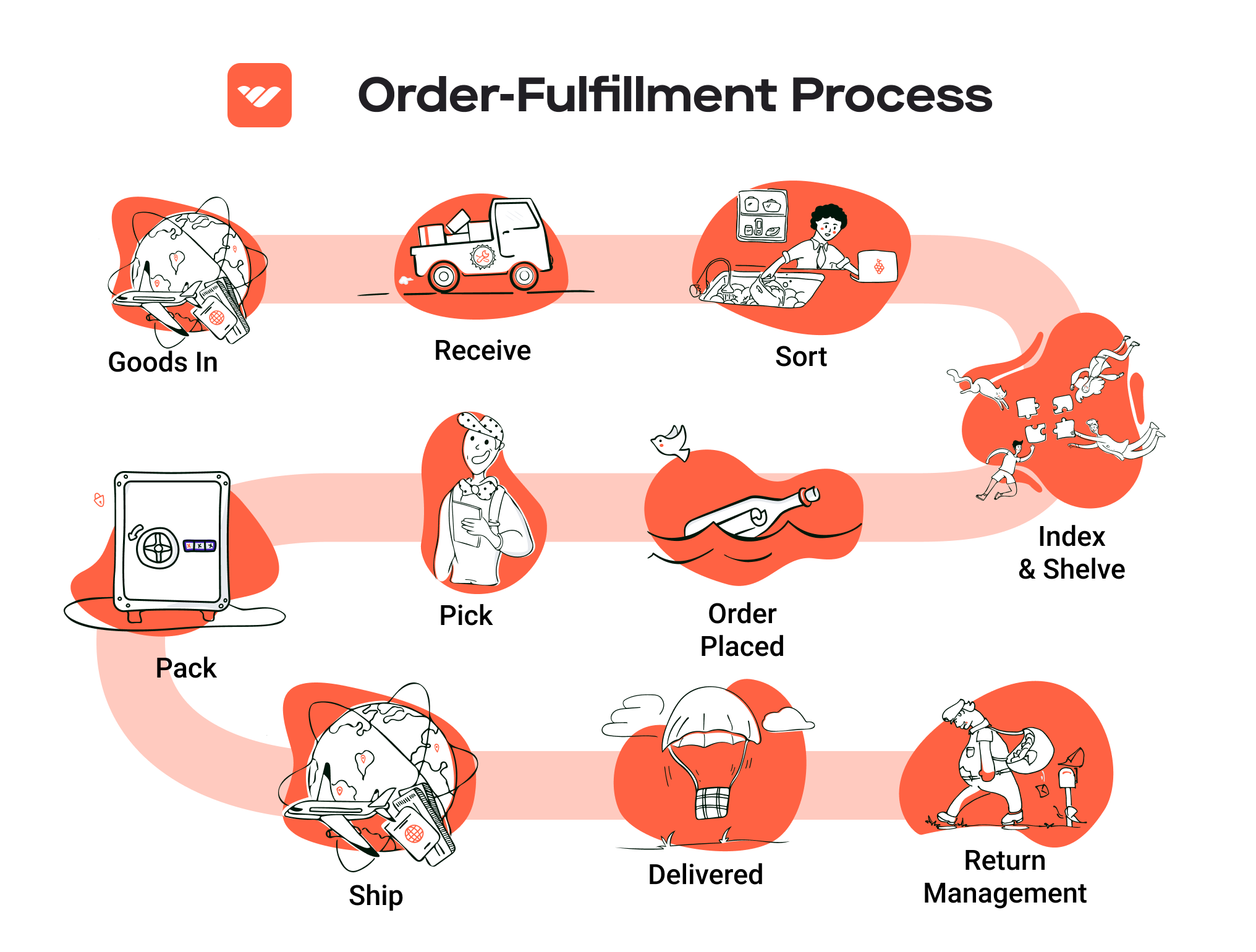
2. Customer Trust
When sellers use FBA, their products benefit from Amazon’s trusted brand reputation. Customers are more likely to buy from sellers who use FBA due to the assurance of quality service, easy returns, and reliable shipping. This trust can lead to increased conversion rates and repeat purchases.
3. Multi-Channel Fulfillment
FBA allows sellers to fulfill orders from multiple channels, not just Amazon. This means that whether a customer buys from an Amazon listing or directly from a seller’s website, Amazon can handle the fulfillment, streamlining logistics and ensuring consistency in service.
4. Simplified Logistics
By outsourcing fulfillment to Amazon, sellers can focus on other critical aspects of their business, such as product development and marketing. Amazon’s extensive logistics infrastructure means that sellers do not need to invest in their own warehousing, shipping, or customer service operations.
5. Advanced Tools and Analytics
FBA provides sellers with access to Amazon’s tools and analytics, enabling them to track inventory, sales trends, and customer feedback. This data can be invaluable for making informed business decisions and optimizing product offerings.
Cons of Using FBA
1. High Fees
FBA comes with various fees, including storage fees for inventory and fulfillment fees based on the size and weight of items. For sellers with low margins or slow-moving inventory, these costs can quickly add up and eat into profits.
2. Strict Inventory Rules
Amazon has specific rules regarding inventory management, including limits on storage space and requirements for labeling and packaging. Sellers must adhere to these rules or risk incurring additional fees or having their inventory removed.
3. Commingling Risks
When using FBA, products from different sellers can be stored together in Amazon’s warehouses. This commingling can lead to issues such as receiving returns for products that were not originally sold by a seller, which can complicate inventory management and customer service.
4. Limited Control
By using FBA, sellers relinquish some control over the fulfillment process. This includes shipping methods and packaging, which can affect branding and customer experience. Sellers must trust Amazon to maintain their standards.
5. Potential for Stockouts
If a seller’s inventory runs low, they risk stockouts, which can hurt their sales ranking and visibility on Amazon. Managing inventory levels becomes crucial, especially during peak shopping periods.
Who is FBA Best For?
Fulfillment by Amazon is best suited for e-commerce businesses that:
-
Have high sales volume: Businesses that can sell large quantities of products can often absorb the FBA fees more effectively, making it a cost-efficient option.
-
Sell products that qualify for Prime: If a seller’s products are suitable for Prime, they can take advantage of the increased visibility and customer trust that comes with being part of the Prime program.
-
Are looking to scale quickly: For businesses that want to expand rapidly without the overhead of managing their own fulfillment operations, FBA offers a scalable solution.
-
Focus on e-commerce as a primary channel: If a business relies heavily on Amazon for sales, FBA can provide a seamless way to manage logistics and improve customer satisfaction.
In conclusion, while FBA provides numerous benefits such as Prime eligibility and simplified logistics, it also presents challenges like high fees and strict inventory regulations. E-commerce businesses must weigh these factors carefully to determine if FBA aligns with their operational goals and customer service standards.
Core Services Offered by Fulfillment Centers
Inventory Management & Warehousing
Inventory management and warehousing are foundational services offered by fulfillment centers. These facilities are equipped to receive, store, and manage inventory efficiently. When an e-commerce business partners with a fulfillment center, they benefit from organized storage solutions that optimize space and enhance inventory tracking.
What It Is:
Fulfillment centers employ sophisticated inventory management systems that automate the tracking of stock levels, manage reorder points, and provide real-time visibility of inventory. This includes categorizing products, monitoring expiration dates (if applicable), and forecasting demand based on sales trends.
Benefits to E-commerce Businesses:
1. Cost Efficiency: By outsourcing inventory management, businesses can reduce overhead costs associated with maintaining their own warehouses. This includes savings on rent, utilities, and staff.
2. Scalability: Fulfillment centers allow businesses to scale operations seamlessly. As demand fluctuates, they can easily adjust storage space and inventory levels without the need for significant capital investment.
3. Improved Accuracy: Automated systems reduce human error in inventory counts, ensuring that businesses have the right products on hand at all times. This accuracy is crucial for maintaining customer satisfaction and avoiding stockouts or overstock situations.
Pick and Pack Services
Pick and pack services are crucial for the order fulfillment process, where individual items are selected from inventory, packed securely, and prepared for shipping.
What It Is:
The pick and pack process begins when an order is received. Fulfillment staff retrieve the ordered items from the warehouse, assemble them, and pack them according to best practices to ensure safe transit. This may include using appropriate packing materials and labeling for shipping.
Benefits to E-commerce Businesses:
1. Speed and Efficiency: Fulfillment centers specialize in quick order processing, which translates to faster shipping times. This is especially important for e-commerce businesses that promise quick delivery to customers.
2. Quality Control: Many fulfillment centers have quality checks in place to ensure that the correct items are picked and packed, reducing the likelihood of returns due to shipping errors.
3. Customization Options: Businesses can offer personalized packaging solutions, such as branded boxes or custom notes, which enhance the customer experience and foster brand loyalty.
Kitting and Assembly
Kitting and assembly services involve combining multiple products or components into a single package or kit, ready for sale or distribution.
What It Is:
This service is particularly useful for businesses that sell items that are often bundled together or require assembly before they can be shipped. For example, a business selling a DIY furniture kit would benefit from kitting services to assemble the necessary components into a single package.
Benefits to E-commerce Businesses:
1. Enhanced Product Offerings: Kitting allows businesses to create bundled offers that can increase average order values. By presenting items together, businesses can encourage customers to purchase more than they might have individually.
2. Streamlined Operations: By outsourcing kitting and assembly, businesses can reduce the complexity of their operations. This allows them to focus on core activities like marketing and product development while ensuring that their products are packaged correctly.
3. Reduced Shipping Costs: Kitting can lead to lower shipping costs as combined products often weigh less than shipping items separately, and fewer packages mean reduced handling fees.
Returns Management (Reverse Logistics)
Returns management, also known as reverse logistics, is the process of handling returned products efficiently and effectively.
What It Is:
Returns management encompasses all activities related to receiving, processing, and restocking returned items. This can involve inspecting the returned products, determining their condition, and deciding whether they can be resold, refurbished, or need to be disposed of.
Benefits to E-commerce Businesses:
1. Customer Satisfaction: A smooth returns process enhances customer trust and satisfaction. When customers know they can easily return products, they are more likely to make purchases, knowing they have options if the product doesn’t meet their expectations.
2. Data Insights: Analyzing return data can provide valuable insights into product quality, customer preferences, and potential issues. This feedback loop can inform product development and marketing strategies, ultimately leading to improved offerings.
3. Cost Recovery: Efficient returns management can help recover costs associated with returned products. By refurbishing or repackaging items, businesses can minimize losses and even resell products that are still in good condition.
In conclusion, partnering with a fulfillment center provides e-commerce businesses with a suite of services that streamline operations, enhance customer experience, and support scalability. By leveraging inventory management, pick and pack, kitting, and returns management, businesses can focus on growth while ensuring their logistics are handled by experts.
How to Choose a Fulfillment Partner: A 6-Point Checklist
Location & Warehouse Network
Importance:
The geographical location of a fulfillment partner is critical for ensuring timely deliveries and minimizing shipping costs. A partner with a well-distributed network of warehouses can significantly reduce transit times, enhancing customer satisfaction.
Questions to Ask:
– Where are your fulfillment centers located?
– How many warehouses do you operate, and are they strategically placed to cover my target markets?
– What is your average shipping time to key regions?
– Do you have options for same-day or next-day delivery?
Technology & Integrations
Importance:
The efficiency of a fulfillment operation is heavily dependent on technology. A partner that utilizes advanced software can streamline processes such as inventory management, order tracking, and data analysis. Additionally, seamless integration with your existing e-commerce platforms is crucial for smooth operations.
Questions to Ask:
– What technology do you use for inventory management and order processing?
– Can your system integrate with my current e-commerce platform (e.g., Shopify, WooCommerce)?
– How do you handle real-time inventory updates?
– What reporting capabilities do you offer to track performance and analyze data?
Specializations (e.g., Cold Storage, Oversized Items)
Importance:
Different businesses have unique fulfillment needs. If you deal with specific products like perishables, oversized items, or fragile goods, it’s essential to partner with a fulfillment provider that specializes in those areas. This ensures that your products are handled correctly and that compliance with industry regulations is maintained.
Questions to Ask:
– Do you have specialized facilities for handling specific types of products, such as cold storage or oversized items?
– What certifications do you hold for handling sensitive goods?
– Can you accommodate seasonal fluctuations in inventory for specialized products?
– How do you ensure quality control for specialized items during the fulfillment process?
Scalability & Capacity
Importance:
As your business grows, your fulfillment needs will evolve. A good fulfillment partner should be able to scale operations to match your growth, whether that means increasing storage capacity or enhancing shipping capabilities. This adaptability can prevent operational bottlenecks during peak seasons.
Questions to Ask:
– What is your current capacity for order fulfillment, and how quickly can you scale up if my order volume increases?
– How do you handle peak seasons, such as holiday sales or product launches?
– Are there any limitations on the types of products you can store or fulfill as I grow?
– What contingency plans do you have in place for unexpected demand surges?
Pricing and Contracts
Importance:
Understanding the pricing structure and contract terms of a fulfillment partner is vital for budgeting and financial planning. Transparent pricing can help you avoid unexpected costs, while flexible contracts can provide the freedom to adapt to changing business needs.
Questions to Ask:
– What is your pricing model (e.g., per order, per item, monthly fees)?
– Are there additional costs for services such as returns handling, storage, or special packaging?
– Can you provide a detailed breakdown of all fees?
– What are the terms of the contract, and is there a minimum commitment period?
– How do you handle contract adjustments as my business evolves?
Customer Support & Reviews
Importance:
Effective customer support is essential for addressing issues that may arise during the fulfillment process. A partner with a strong customer service reputation can help resolve problems quickly, ensuring that your business operations run smoothly. Additionally, reviews and testimonials can provide insight into the partner’s reliability and quality of service.
Questions to Ask:
– What customer support options do you offer (e.g., phone, email, chat)?
– What are your average response times for customer inquiries?
– Can you provide references or case studies from current or past clients?
– How do you handle disputes or issues that arise during the fulfillment process?
– What measures do you take to ensure customer satisfaction?
Conclusion
Choosing the right fulfillment partner is a critical decision that can significantly impact your e-commerce business’s success. By evaluating potential partners against this 6-point checklist, you can make an informed choice that aligns with your operational needs and growth goals. Remember, the right fulfillment partner will not only help you streamline your logistics but will also enhance your customer experience, positioning your business for long-term success.
Understanding Fulfillment Pricing: A Breakdown of Common Fees
Initial Setup Fees
Initial setup fees are typically charged by fulfillment centers to cover the costs associated with integrating your business into their system. This fee often includes onboarding, software configuration, and the establishment of your inventory within their warehouse. The cost can vary significantly depending on the complexity of your operations and the systems in place at the fulfillment center.
To calculate these fees, fulfillment companies may consider factors such as the size of your inventory, the number of SKUs (stock-keeping units), and the specific integrations required with your e-commerce platform. It’s crucial to ask for a breakdown of these fees upfront, as they can sometimes be negotiable depending on your business’s expected volume.
Receiving Fees
Receiving fees are charged when your products arrive at the fulfillment center. This fee covers the labor and equipment needed to unload, inspect, and store your products. Typically, fulfillment centers charge per shipment received, but some may also apply a fee per item or pallet, depending on how they manage incoming goods.
The calculation for receiving fees can vary based on the following factors:
– Volume of Products: Larger shipments may incur a reduced rate per item.
– Type of Goods: Special handling requirements for fragile or heavy items may increase the fee.
– Inspection Needs: If your products require quality checks upon arrival, this can add to the cost.
Understanding how your fulfillment partner calculates receiving fees is essential, especially if you plan to send frequent shipments.
Storage Fees (per pallet/bin)
Storage fees are incurred for the space your inventory occupies in the fulfillment center. These fees are typically calculated on a monthly basis and can be charged per pallet, bin, or cubic foot, depending on the fulfillment company’s pricing model.
To break down how storage fees are calculated:
– Pallet-Based: If your products are stored on pallets, you may pay a set fee for each pallet stored monthly.
– Bin-Based: For smaller items, fulfillment centers may charge based on the number of bins or shelves used.
– Cubic Foot: Some companies may charge based on the total cubic footage your inventory occupies.
It’s vital to monitor your inventory levels to avoid unnecessary storage costs, especially during off-peak seasons or when you have slow-moving products.
Pick & Pack Fees (per item/order)
Pick and pack fees are charged for the labor involved in retrieving items from storage, packing them for shipment, and preparing them for delivery. This fee can be structured in various ways, typically charged per order or per item picked and packed.
Calculating pick and pack fees involves:
– Per Order Fee: A flat rate for each order fulfilled, regardless of the number of items.
– Per Item Fee: A charge for each individual item picked from storage, which can be more suitable for businesses with high variability in order sizes.
Understanding the structure of these fees can help you optimize your order management and potentially minimize costs by consolidating orders where feasible.
Shipping Fees
Shipping fees are one of the most variable costs in fulfillment pricing. These fees cover the cost of transporting your products from the fulfillment center to the customer and can vary based on several factors, including:
– Shipping Carrier: Different carriers have different rates, and fulfillment centers often have partnerships that can reduce costs.
– Destination: Shipping to international locations or remote areas typically incurs higher fees.
– Package Dimensions and Weight: Heavier or larger packages may attract higher shipping fees, so optimizing packaging can lead to cost savings.
Many fulfillment centers offer tiered pricing based on shipping volume, which can be beneficial for businesses scaling up. It’s wise to discuss your shipping needs and volume expectations upfront to get the most accurate quotes.
Tips for Getting an Accurate Quote
-
Provide Detailed Information: Be upfront about your inventory size, order volume, and specific needs. This helps fulfillment centers give you a more precise quote.
-
Request a Breakdown of Fees: Ask for a detailed breakdown of all potential costs, including any hidden fees that may not be immediately apparent.
-
Compare Multiple Providers: Don’t settle for the first quote. Compare multiple fulfillment companies to understand the market rate and ensure you’re getting the best deal.
-
Consider Volume Discounts: If you anticipate high order volumes, inquire about bulk pricing or discounts that could lower your overall costs.
-
Negotiate: Many fulfillment companies are open to negotiation, especially if you can demonstrate potential for high volume or long-term business.
By understanding these common fees and how they are calculated, you can make informed decisions when choosing a fulfillment partner, ultimately helping your e-commerce business scale efficiently.
Frequently Asked Questions (FAQs) about Fulfillment
1. What is a 3PL (Third-Party Logistics) provider?
A 3PL provider is a company that offers a range of logistics services to businesses, including warehousing, transportation, order fulfillment, and inventory management. By outsourcing these functions to a 3PL, businesses can focus on their core operations while leveraging the provider’s expertise and resources to enhance efficiency in the supply chain.
2. How do fulfillment services work?
Fulfillment services involve a series of steps that begin when products arrive at a fulfillment center. The process includes receiving inventory, storing it, picking items when orders are placed, packing them for shipping, and finally delivering the orders to customers. Fulfillment services streamline these operations, allowing businesses to manage their order processing without the need for in-house logistics.
3. What is the difference between a warehouse and a fulfillment center?
While both warehouses and fulfillment centers store goods, their functions differ significantly. A warehouse primarily serves as a storage facility for inventory, often holding products for extended periods. In contrast, a fulfillment center is designed for rapid movement of goods, focusing on order processing, picking, packing, and shipping to ensure quick delivery to customers.
4. How much do fulfillment services cost?
The cost of fulfillment services can vary widely based on several factors, including the volume of orders, the type of products being stored and shipped, storage space needed, and additional services like returns management. Typically, fulfillment companies charge based on storage fees, order processing fees, and shipping costs. It’s essential to request a detailed quote from potential providers to understand the pricing structure.
5. What are the benefits of using a 3PL fulfillment company?
Using a 3PL fulfillment company offers multiple advantages, including reduced operational costs, access to advanced technology and logistics expertise, scalability as your business grows, improved customer satisfaction through faster shipping, and the ability to focus on core business activities like marketing and product development instead of logistics.
6. Can a 3PL handle international shipping?
Yes, many 3PL providers specialize in international shipping and can manage customs clearance, freight forwarding, and global logistics. They often have established partnerships with various carriers and can provide businesses with the necessary expertise to navigate international shipping regulations and requirements.
7. What should I look for when choosing a 3PL partner?
When selecting a 3PL partner, consider factors such as their industry experience, technology capabilities (like integration with your e-commerce platform), service offerings (including returns management and customer service), scalability options, pricing structure, and customer reviews. It’s also vital to ensure that their fulfillment processes align with your business needs and customer expectations.
8. How does a fulfillment center improve customer satisfaction?
Fulfillment centers enhance customer satisfaction by ensuring that orders are processed quickly and accurately. They employ efficient systems for inventory management and order fulfillment, which reduces errors and shipping delays. Additionally, many fulfillment centers offer features like real-time tracking and flexible shipping options, which provide customers with transparency and convenience.
9. What happens if there’s an issue with an order?
If there’s an issue with an order, such as a damaged item or incorrect shipment, the fulfillment center typically has a process in place to handle returns and exchanges. Most 3PL providers offer returns management services, allowing for a streamlined return process that minimizes inconvenience for customers and helps maintain satisfaction.
10. How can I integrate my e-commerce platform with a 3PL provider?
Integrating your e-commerce platform with a 3PL provider usually involves using API connections or built-in integrations offered by the 3PL. Most fulfillment companies provide documentation and support to help set up these integrations. Ensure that your chosen 3PL can seamlessly connect with your platform to automate order processing, inventory updates, and shipping notifications, thus enhancing overall operational efficiency.
Conclusion: Is Outsourcing Fulfillment the Right Move for Your Business?
Evaluating the Benefits of Outsourcing Fulfillment
Outsourcing fulfillment can be a game-changer for e-commerce businesses looking to streamline operations and foster growth. One of the primary advantages is the significant time savings it offers. By entrusting inventory management, order processing, and shipping to a third-party logistics (3PL) partner, business owners can focus on core activities such as product development and marketing, rather than getting bogged down in logistical details.
Scalability is another key benefit of utilizing a fulfillment service. As your business grows, so too will your order volume and complexity. A reliable 3PL provider can adapt to these changing demands, providing the infrastructure necessary to scale operations without the burden of investing in additional warehousing or staffing. This flexibility allows businesses to enter new markets and respond to seasonal fluctuations with ease.
Moreover, partnering with a fulfillment service brings a wealth of expertise and technology to the table. Experienced 3PL companies are equipped with advanced logistics solutions and industry best practices that can enhance operational efficiency and improve customer satisfaction. They can also offer insights into shipping optimization, inventory management, and returns handling, which can significantly elevate your business’s performance.
However, choosing the right fulfillment partner is crucial. The wrong choice can lead to inefficiencies, customer dissatisfaction, and hindered growth. It’s essential to conduct thorough research, assess your specific needs, and ensure that the 3PL you select aligns with your business goals.
As you consider your options, take a moment to audit your current shipping and fulfillment processes. Are they serving your business effectively? If not, it may be time to explore the potential benefits of a fulfillment partner. Embrace the opportunity to enhance your operations and drive your business forward.
Important Disclaimer
⚠️ Important Disclaimer
The information in this guide is for educational purposes. Fulfillment services, pricing, and platform features change frequently. Always conduct your own due diligence and consult with providers directly before making business decisions.


